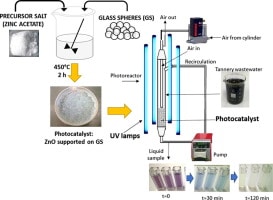V Vaiano, G Iervolino – Journal of Colloid and Interface Science, 2018
Abstract
In order to apply the photocatalytic processes on a real scale for the treatment of industrial wastewaters, the use of slurry reactors employing suspended photocatalysts is not suitable due to the need for an uncomfortable and expensive separation phase of photocatalyst. To overcome this disadvantage, the photocatalyst particles must be immobilized on a transparent support: our work proposes, for this reason, a simple and cost effective method for the deposition of ZnO photocatalyst on glass spheres in order to formulate a structured photocatalyst effective in the treatment of aqueous solutions containing various organic dyes, commonly used in the tannery industries and in the treatment of a real wastewater at high COD content (11 g/L) coming from the refining unit of the tanning process. In particular, ZnO was immobilized on glass spheres (ZnO/GS) with a simple dip coating method, starting from zinc acetate aqueous solution, without using complexing agent and strong basic compounds. The optimization of ZnO amount on glass spheres was evaluated employing Acid Blue 7 dye, as model pollutant. In particular, it was found that best performances in terms of discoloration and mineralization of the target dye were obtained using the photocatalyst with a ZnO loading equal to 0.19 wt% (ZnO_ac1), prepared through only one dip-coating step. Moreover, the ZnO_ac1 photocatalyst can be easily separated from the reaction mixture, maintaining excellent photocatalytic activity and durability even after several reuse cycles. Finally, ZnO_ac1 showed a high photocatalytic activity in the treatment of the real wastewater, obtaining a COD removal equal to 70% after 180 min of UV light irradiation.

… The photon flux at reactor external surface, obtained through actinometrical technique using a spectro-radiometer (StellarNet Inc), was 25 mW/cm 2 [40]. The amount of structured catalyst was 50 g. The volume of the treated aqueous solution was 60 mL …





